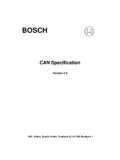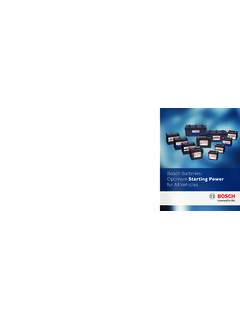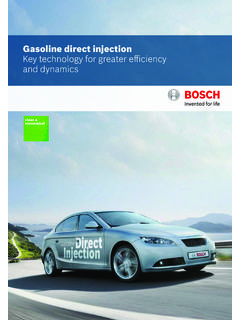Transcription of Bosch D-Jetronic
1 Mercedes-Benz: 250E, 280, 300, 350, 450 Porsche: 914 Saab: 99 EVolkswagen: Type 3 & 4 Volvo: 1800E, 1800ES, 142, 144, 164 ECitro n: SM, DSBMW: (early types)Jaguar XJ-S, XJ12 Bosch D-JETRONICM anifold Pressure Control system (MPC)DescriptionThe Bosch D-Jetronic electronic fuel injection system is composed of 3 majorsubsystems: the air intake system, the fuel system, and the electronic control system. TheD- jetronic system uses constant fuel pressure and flow, so that only injection durationneeds to be modified to control air/fuel mixture. The D-Jetronic system measuresincoming airflow by monitoring intake manifold pressure. Engine speed, temperature, andother factors are monitored for the purpose of fine-tuning injection duration. An auxiliaryair valve, cold start injector and thermotime switch aid in cold starting and systemAn electrically driven fuel pump forces fuel through a filter, into the main system.
2 Mainsystem consists of one injector for each cylinder, a cold start injector and a pressureregulator, which maintains fuel pressure at 28 psi ( kg/cm2). A secondary systemcarries excess fuel from the pressure regulator back to 1: Sectional View of Fuel InjectorFig. 2: Sectional View of Cold Start InjectorAir systemIntake manifold, connected to an intake air distributor, supplies the cylinders with air. Apressure sensor is connected to intake air distributor. Thepressure sensor operatesaccording to difference in manifold pressure and atmospheric pressure and signals controlunit accordingly. A throttle valve, operated by accelerator pedal, is located at the mouthof the intake air distributor. The throttle valve and intakeair distributor are connected toair cleaner by an air duct elbow. The idling air system is in the form of a by-pass systemlocated between the air filter and air intake distributor.
3 Its size can be varied with anidling air adjusting auxiliary air line, from air cleaner (auxiliary air valve), to intake air distributor formsthe warming-up air system. Its volume is varied, depending on engine temperature, by theauxiliary air control systemElectronic Control UnitControl unit regulates the correct amount of fuel to be injected, depending on enginespeed, intake pressure and engine temperature. When ignition is switched on, control unitreceives its operating voltage directly from battery, via voltage supply relay. It alsocontrols the fuel pump, which normally is provided with current from pump relay, onlywith engine running. A time switch, in control unit, allows fuel pump to runapproximately 1 to seconds after ignition is turned on, The control unit is connected toall sender units by a special wiring harness, coupled to a multiple plug. The control unit isusually located inside vehicle under the dash, under one of the seats or in the SensorThe pressure sensor is located in the engine compartment andis connected to the intakemanifold by a vacuum hose.
4 This sensor controls the basic amount of fuel to be injected,depending on pressure in the intake manifold and load on the Intake Temperature SensorThe air temperature sensor provides control unit with information about air temperature,so that control unit can increase the injection quantity as necessary at low intake airtemperature. This compensation ceases when intake air temperature is greater than 68 F(2O C).Engine Temperature SensorThe engine temperature sensor provides the control unit with information about coolanttemperature (cylinder head temperature on VW). This enables control unit to adaptinjection interval and determine how long the cold start injector should remain openduring cold ContactsThe triggering contacts are located in the distributor. They provide signals whichdetermine when and to which cylinder fuel is to be injected. The contacts also supplyinformation concerning engine speed to determine the amount of fuel that needs to beinjected into the 3: Triggering Contacts & DistributorThrottle Valve SwitchThe throttle valve switch is mounted on the throttle housing.
5 This switch signals thecontrol unit of throttle position. During deceleration, above 1500 RPM, throttle switchcuts fuel supply off and below 900 RPM, fuel supply is turned 4: Throttle Valve Switch AssemblyAuxiliary Air ValveDuring cold starts, the auxiliary air valve opens to allow additional air into the inlet engine heats up, a bi-metallic element expands and closesvalve. At approximately140 F (80 C) the auxiliary air pipe is completely closed by the 5: Auxiliary Air Valve AssemblyTrouble shootingPreliminary checksPrior to trouble shooting the fuel injection system, check the following items:Battery electrical or mating surfaces for vacuum lines for speed and shootingEngine Will Not Start, Fuel Pump InoperativeCheck the following: Defective fuse, fuel pump. fuel pump relay, main relay orelectrical circuit. Fuel pump relay should click when ignition is switched on andoff. Should have voltage from main relay terminal No.
6 87 to fuel pump relayterminal No. 86. Fuel pump relay terminal No. 85 should have good ground :Fuel pump operates approximately to 1 second after switchingignition on. Relay is grounded from ECU. Ensure fuel pump operates Will Not Start, Fuel Pump OperatesCheck the following: Defective wire to starter terminal , Manifold PressureControl (MPC) sensor and/or wiring, temperature sensors and/or wiring. Inadequatepressure in main fuel system, wire connector for distributor contacts disconnectedand/or open circuit. Pressure should be 28 psi ( kg/cm2) with starter Starts, Then Stalls When ColdCheck the following: Defective trigger contacts and/or wiring, MPC sensor ortemperature Will Not Start WarmCheck the following: Defective thermotime switch, temperature sensors or highresistance at trigger Stalls And May MisfireCheck the following: Excessive resistance at trigger contacts, dirty trigger contacts,loose connector, temperature sensors or inadequate vehicle Runs Rough, White Smoke Comes From ExhaustCheck the following: Injector sticking or connection to injector windings of PowerCheck the following: Defective MPC sensor, fuel pressure too low, restricted airthrottle valve or full-load contact does not Fuel ConsumptionCheck the following: Defective sensors, ECU, MPC, improperly adjusted throttleswitch or inadequate fuel Idles Erratically Between 1000 and 2000 RPMC heck the following.
7 Hose between auxiliary air regulator and intake air distributordisconnected or cracked, throttle valve not closed at idle or idle speed too Idle, UnadjustableCheck the following: Vacuum leak, injector valve "0" ring leaking or throttle valveout of & diagnosisNOTE:The ECU ground terminal, terminal No. 11, is used for electrical circuit continuity exists between terminal No. 11 of the ECU and the vehicle supply1. Turn ignition on. Measure voltage between ECU terminals No. 16 and 11 of ECUconnector. Measure voltage between ECU terminals No. 24 and11 of ECU Fig. 10 or 11. If volts are present, proceed to step 4). If no voltage isobtained, proceed to next step. If voltage is less than 11 volts, proceed to step 3).2. If no voltage is present, check for open circuit in wire from main relay to ECU, defectivemain relay and/or ignition switch. Check for voltage at mainrelay terminals No. 86, 30/51and 87.
8 Replace relay as If voltage is less than 11 volts, check for resistance in wires and/or connectors at ECU andmain relay. Repair or replace as If voltage supply to ECU and main relay is okay, check for voltage between terminal on starter and ground. If 9-12 volts are present. system isokay. If no voltage but starteroperates. repair open in wire from starter terminal No. 50 toECU terminal No. 18. if lessthan 9 volts, check battery and resistance in wire from ignition switch to starter. If novoltage and starter is inoperative, replace ignition switch and/or repair open wire pump1. Connect pressure tester in fuel line between fuel pump andfuel supply lines. Removeinjectors, fuel supply lines to intake manifold and cold start injector valve. Place panbeneath all injectors, to catch fuel being discharged. Connect remote starter switch toterminal No. 50 on starter and to positive terminal of battery.
9 Run starter and check thatall injectors spray properly and evenly. If any one injectordoes not spray correctly,replace that Remove wire from terminal No. 33 of thermotime switch and ground the removed wire. ifcold start injector does not spray, replace it. Operate starter and check fuel should be psi (.21 kg/cm2). If pressure is below specifications, crimp off fuelreturn line. Pressure should increase to psi ( kg/cm2).3. If pressure does not increase, or increase is not sufficient, check fuel filter, lines and/orpump. Remove crimp in fuel return line. if pressure is above initial specifications, adjustpressure regulator. If pressure does not decrease when crimped line is released, replacepressure Pressure Control (MPC) sensor1. Disconnect the harness connector at the MPC. Check the resistance at the MPCterminals. Terminal No. 11 is the ground circuit, there should be infinite resistance (opencircuit) between terminal No.
10 11 and terminals No. 7, 8,10, and 15. Check primaryresistance between terminals No. 7 and 15. Resistance should be about 90 ohms. Checksecondary resistance between terminals No. 8 and 10. Resistance should be about 350ohms. If resistance values are not to specifications or a short (continuity) exists betweenthe ground circuit (terminal No. 11) and any of the other terminals, replace the To check the harness, ensure MPC is disconnected and ignition is off. With the ECUconnected ensure continuity exists between terminal No. 11, at the MPC connector, andvehicle chassis. If there is resistance in this circuit or anopen exists, check ECU groundcircuit. Disconnect the ECU connector. Check wiring continuity between the ECU andMPC connectors. If there is resistance (above 5 ohms) or an open, repair or replace wiringas necessary. With ECU and MPC disconnected there should notbe continuity betweenharness terminals No.





